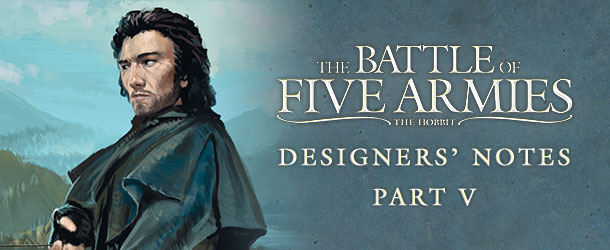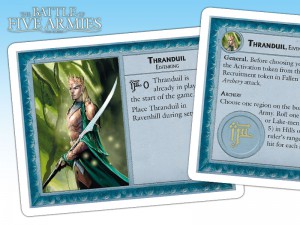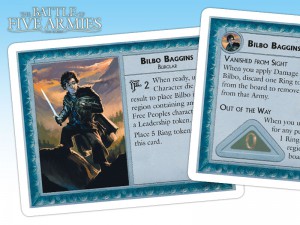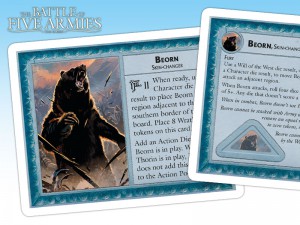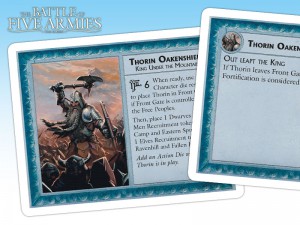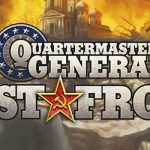As we wrote in the previous article “A Long Journey Begins,” one of the design goals of The Battle of Five Armies was to give a more important and definite role to the characters in the battle.
In our previous designs in this series, War of the Ring and Battles of the Third Age, characters are very streamlined. These designs are more strategic in scope. Differences in personal combat skills and abilities disappear at this scale.
There are numerous characters fighting in the Battle of Five Armies and Tolkien, as befitting an epic tale, focuses a lot of his narrative around them: Thorin crashing out of the Front Gate, Bilbo wearing the Ring and vanishing, Gandalf meditating on the Hillock to prepare a final spell when the battle appears to be lost... These images are strongly engraved in the memory of any reader of "The Hobbit." We wanted the possibility of creating these kinds of moments in our game.
It's easy to understand some of the heroic figures in the battle will have a stronger presence from a military point of view. The Elven-King (Thranduil, even if he’s never named in "The Hobbit"), leading the host from Woodland Realm; Dàin, with the stout dwarves from the Iron Hills; Bard, heir of Kings, Dragon-slayer; the Lord of the Eagles, noblest of the Eagles of the Misty Mountains. And of course, Gandalf – Wizard and Counselor, with wise words able to forge the alliance of the Free Peoples against the Shadow. All these military leaders (called “Generals,” in the game) are key figures. Each of them is responsible of one of the Free Peoples armies at the battle.
As we said, we wanted to go beyond the role they had in the “old” systems (enhancing the action capability of an Army, thanks the Character die; providing Leadership to grant re-rolls). So, we decided to add specific abilities to each of these characters. Thranduil inspires the Elves to great feats of archery, attacking their enemies from afar. Dàin and Bard are capable of raising and inspiring their troops. Gandalf… We decided to grant him a powerful bolt of magic, which he can further enhance by entering deep meditation. Gandalf’s magical prowess has been long debated by readers of Tolkien’s works, but in "The Hobbit," he seems to be clearly capable of casting magic with a direct damage effect. The Lord of the Eagles is special, just like the other Eagles – more about him in our next article.
Activating Generals is a key decision the Free People player makes at the beginning of each turn. Only the abilities of active Generals may be used (and they can often create interesting “combos” with the normal actions, as using an ability is not an action). However, the Shadow player's Fate draw is influenced by the number of active Generals. If there is more than one active General, the Shadow has a chance to re-draw Fate tokens, improving his chances to get a smaller increment on the Fate Track. This creates an important trade-off, because abilities are important, and Generalship in The Battle of Five Armies is modeled through the use of characters and Leadership tokens: the Generals you activate in a turn grant you both their abilities and additional Leadership tokens, which are critical for moving, rallying, and supporting Free People armies in combat.
Generals are not the only characters in the game. The Free Peoples include among their ranks the only representative of other peoples of Middle-Earth: Bilbo, the Hobbit, the main character in the story, and Beorn, the Shape-changer. Along with Thorin and the Lord of the Eagles, these characters begin the game off board, and enter play as dictated by the Fate Track.
Bilbo is the first character to enter the game with the Fate Track mechanic (normally on the first or second turn). It was very tricky to properly include him in the design. If we just look at the narrative in the book, we could have left him out of the game completely… He wears the Ring, he’s knocked out, he wakes up when it’s all over! However, this was very anti-climactic, and we well know Hobbits, given the right chance, can make their presence felt in the battle. Pippin and Merry definitely did. Perhaps Bilbo, with a little more luck, could also perform epic feats during the Battle of Five Armies.
Considering this, we decided to give Bilbo an interesting power, inspired by the Ring, and by Bilbo’s proven skill using it to distract enemies and help friends. Bilbo can vanish using the Ring, and by doing so, he deflects some damage from the army he’s with. Later, he can pop-up again, in a different point of the battlefield. This power is not overly strong – but is very thematic, if we look at the Hobbit storyline, and can prove to be very useful at key moments. There is a limit to the use of the Ring, however, represented by a limited supply of “Ring Tokens” used both to disappear and to appear again… So, it is possible for Bilbo to vanish by spending one last Ring Token, and then not reappear until the end of the battle, just like in the book.
Beorn, of course, is a completely different affair. In the book, his arrival spells doom for the Orc host. He sweeps through the ranks of the goblins. He kills Bolg, breaking the morale of the evil army, and gets Thorin away from the thick of the melee. He’s a one-man army and almost single-handedly wins the battle.
Representing Beorn was almost the opposite challenge from Bilbo. Make Beorn too powerful, and, paradoxically, he becomes useless, because his arrival means an automatic defeat of the Shadow.
The solution was found on multiple levels. First of all, Beorn's arrival – just like the arrival of Bilbo, Thorin, and the Lord of the Eagles - is based on the progress of the Fate Track. He’s the last character to arrive, and if the arrival is delayed too long, the Shadow can win before he shows up. On the other hand, Beorn's early arrival may mean an automatic loss for the Shadow.
Secondly, but no less important, Beorn's strength is also linked to Fate. The Fate Deck includes cards which are essentially “upgrades” for Beorn, Thorin, and the Eagles. Depending on which Fate cards enter play, these character's strength and abilities become greater, reaching epic levels when all of the cards for one character are in play. Normally, however, only a few Fate cards will typically show up in a given game of The Battle of Five Armies. So, it is possible, in one game Beorn may be (relatively speaking!) weaker, while in another game he is as effective as he is in the books, crushing through the Shadow army and almost impossible to face…
Beorn's arrival remains a pivotal point in the battle, but it is possible – especially when he’s weaker due to a lack of Fate cards – a concerted attack eliminates him, or his arrival is just too late to have a chance to turn the tide…
The third Free People character linked to Fate is Thorin. In the story, his sortie out of the Front Gate seems to turn the tide in the Battle for the Free Peoples. But, when his charge is stopped by Bolg’s bodyguard and he’s overwhelmed by enemies, triumph turns into disaster, and all would be lost, if not for Beorn.
Thorin, at the beginning of the battle, is inside the Mountain along with his dwarven companions. The moment he “enters the game,” as dictated by the Fate Track, represents the fact he’s ready to rush out. However, he might well decide not do this – it could be wiser for him to stay inside the fortified gate, ready to fend off the assaults of the orcs… But, a well-timed sortie could relief the pressure on the allies outside the fortress... The choice between rushing out or defending the Front Gate is another key decision for the Free People player and the influence of Fate cards on Thorin can make an important difference in determining the best decision…
In the next article, we will take a look at the Great Eagles, the Lord of the Eagles and the Great Bats.

